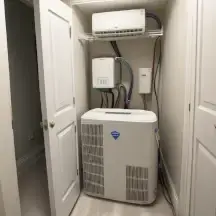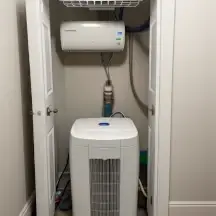Home Dehumidifier
Whole Home Dehumidifier Specialists Serving Knoxville, Oak Ridge, TN & More!
Excess moisture in the home can create many different issues, from musty odors to more serious concerns such as mold growth and structural damage, health concerns and safety risks. If you live in a humid environment , investing in a whole home dehumidifier could be worth your consideration for optimal air quality and comfort.
PROBLEMS WITH MOISTURE IN YOUR HOME
As temperatures warm up in spring and summer months, humidity levels also rise accordingly. Increased steam and moisture in the air can result in elevated humidity levels in your home; when interior humidity levels exceed 35%-50% this can create several issues within its air.
Respiratory issues:
An excess of moisture in your home can pose respiratory challenges for you and your family members, particularly if any are affected by mold mildew allergies or asthma. Mold thrives in warm, moist conditions so if it lingers in the air it could provide the ideal breeding ground for mold growth – as well as pollen, mold spores, pathogens that could irritate respiratory systems of those living there – especially those suffering from mold allergies or breathing challenges such as asthma.
HVAC issues:
Heating up your home makes your HVAC unit work harder, which increases utility costs and wear and tear on its system. Changes in moisture can have adverse impacts on wallpaper and furniture in the home.
Increased condensation:
An increase in condensation could create issues with both windows and air ducts, with window condensation potentially leading to mold growth as well as musky odor. Conversely, condensation in air ducts especially with metal shell ductwork provides the perfect breeding ground for mold growth that spreads into walls and sends off musky scents into your home.
Warping and Rotting:
Wood furniture and structures can become warped or cracked over time as moisture levels in the air change, as wood tends to contract or expand with humidity shifts causing it to warp or crack over time.
An effective solution for eliminating excess moisture in your home’s air is adding a whole house dehumidifier to your HVAC system.
What Is A Whole Home Dehumidifier?
 A whole-home dehumidifier activates when relative humidity reaches an unfavorable threshold in your home.
A whole-home dehumidifier activates when relative humidity reaches an unfavorable threshold in your home.
A whole-home dehumidifier works alongside your current HVAC system to reduce excess moisture in your home when necessary. A whole home dehumidifier reduces excess moisture by forcing all air passing through your ductwork through it first; then all air that passes back out passes through another whole-house dehumidifier – similar to how central air conditioners remove moisture – this time through cooling air passing over a reservoir or outflowing drain and captures any condensation generated as part of cooling, expelling it outside and expelled through either reservoir or outflowing drain – unlike air conditioners which return cooled, dried air back into your home after expulsion by whole-house dehumidifiers rather than air conditioners!
As whole-home dehumidifiers are integrated with HVAC systems, their humidity can be managed using a thermostat or humidistat to adjust to your personal preferences and set auto adjustments as necessary.
Installing and Maintaining a Whole Home Dehumidifier
While installing and maintaining a whole home dehumidifier isn’t quite DIY-friendly, the process itself is straightforward, with most dehumidifiers connecting seamlessly with HVAC systems in your home or being added when upgrading an existing HVAC system.
Maintaining your whole home dehumidifier requires only minimal upkeep. As with your cooling system, monitoring its function by checking and cleaning its reservoir tank or condensation drain periodically is required for effective removal of excess moisture removal. Usually however, dehumidifiers require very minimal upkeep – our professional service technician can service it during an annual HVAC tune-up appointment.
BENEFITS OF A WHOLE HOME DEHUMIDIFIER
 A whole-home dehumidifier is an inconspicuous addition to your HVAC system that helps ensure optimal humidity levels are reached in every room of the home.
A whole-home dehumidifier is an inconspicuous addition to your HVAC system that helps ensure optimal humidity levels are reached in every room of the home.
Your air conditioning unit should help eliminate excess humidity in your home’s air, but when not operating it won’t do that. Therefore, in fall and winter when your air conditioner may not be active you may require another device or solution to reduce humidity in your home.
Home dehumidifiers can help relieve pressure on your AC in high humidity months by extracting excess moisture from the air and relieving its burden.
Dehumidifiers help decrease the chances of mold and mildew growth in your home, potentially alleviating health concerns as well as breathing issues for family members with allergies or asthma. Decreased mildew and mold levels will also lower musty odors associated with these issues.
Protect furniture and wood in your home from excessive moisture levels. Too much humidity in the air can cause wood to warp or even rot, while eliminating extra humidity can reduce paint and wallpaper peeling risks.
Whole-home dehumidifiers provide automatic comfort for your home by maintaining the desired humidity level, similar to setting the temperature on an HVAC unit. Simply set the level you would like your dehumidifier to maintain and it’ll automatically click on or off as needed – saving energy use and utility costs by only turning on when required by humidity levels; plus ENERGY STAR-certified models may come with rebates!
Like portable dehumidifiers, whole home dehumidifiers don’t need to be moved around from room to room or stored away regularly for cleaning purposes and will not risk bacteria growth like portables can.
Other Ways To Remove Moisture From Your Home
-
Make Sure That Your Air Conditioner Is Appropriate for Your Home.
An air conditioner sized appropriately for your home should do an effective job of eliminating excess humidity from the air in your living spaces. However, if it is either too large or too small compared to its square footage then this could add even more moisture into the atmosphere of your home.
-
Cultivate Houseplants to Improve Air Quality.
Houseplants are nature’s purifiers. Through photosynthesis and conversion of carbon dioxide into oxygen, houseplants help naturally cleanse the air in your home while simultaneously helping absorb excess moisture from it.
-
Utilize Fans and Ventilation Fans in Your Home.
Ceiling and stand-up fans serve to circulate air throughout your home, helping reduce humidity by aiding evaporation as the air circulates. In bathrooms or over stoves where excess moisture may build up, ventilation fans can draw out moisture to remove it quickly from these areas of excess humidity.
Dehumidifier FAQs.
How can I test the humidity in my home?
A hygrometer is the easiest and cheapest way to gauge humidity levels in any given environment. These devices measure humidity directly, making it an inexpensive and straightforward method of checking humidity levels in any given space. Hygrometers can be found both online retailers as well as most hardware stores; digital or dial versions exist depending on personal preferences.
Some smart thermostats also monitor humidity levels within your home.
When should I use a dehumidifier in my home?
A dehumidifier should be utilized if your humidity levels surpass average (35-50%) levels.
How long does it take a whole-home dehumidifier to work?
A properly sized dehumidifier could take anywhere from 8-12 hours for optimal humidity levels in your home to be reached.
What Size Dehumidifier Do I Need For My Home?
Finding the proper dehumidifier size to add to your HVAC unit can be tricky, depending on factors such as your home’s size, humidity levels and specific system requirements.
Consult a certified HVAC technician in order to find the appropriate size dehumidifier for your home.
